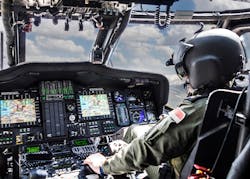The coming of age of artificial intelligence
By Jim Romeo
It’s been about a year since the stand-up of the Chief Digital and Artificial Intelligence Office (CDAO) in the U.S. Department of Defense (DOD). Since its genesis, momentum for AI technology has continued to build.
Military intelligence, once characterized by strategic decision making, paper maps, table-top exercises, and many legacy systems of hardware and software is becoming sophisticated and -- well, artificial, in a very good sense. As artificial intelligence (AI) and machine learning pervades nearly every industry in the world we live in, and boosts innovation and technology in many ways, military and aviation electronic systems are no exception.
Its adoption, however, must be judiciously approached, paying attention to the return on investment and its practicality for so many use cases within military and aerospace environments.
As Hefty Conklin, technical director of department 22 at Raytheon Intelligence and Space in McKinney, Texas puts it: "AI/ML presents some game-changing capabilities, its integration can also drive challenging system requirements -- cost, power and processing. It is not a panacea for every challenge in the contested threat environment. Some of the current capabilities that have been constructed with limited power and processing are highly effective for today’s threat environment. We must use robust systems engineering of any system design to determine the balance, or where and how much AI/ML, combined with other approaches, provides the right amount of capability to manage that set of threats." Onward and upward, we move.
The steep upward slope of AI
AI is on a steep upward slope in its adoptions and utility to the modern warfighter across technology platforms in all service branches, as well as commercial and space aviation systems. Some are in early development, while others are in mid to late development.
The 2022 National Defense Strategy addresses technology priorities of the U.S. as it works to meet the rapidly evolving domains of war. That's prologue to the"Central to these priorities are current and long-term investments in artificial intelligence, autonomy, integrated sensing, and systems, cyber, and quantum science," Leach says. "The NDS mentions further that the DOD has implemented “institutional reforms that integrate our data, software, and artificial intelligence efforts and speed their delivery to the warfighter.” Within the field of defense electronics lies short term need fulfillment for AI driven data and image analysis tools and digital twinning for mission support and training, mid-term delivery of decision support capabilities and multi-domain intelligence synthesis, and long-term realization of a paradigm shift into quantum computing."
The bigger picture
DOD agencies continue to develop cognitive electronic warfare (EW) solutions, which use AI and machine learning technologies to modernize and enhance EW capabilities. Many of these projects have sponsorship from the Defense Advanced Research Projects Agency (DARPA), the U.S. Naval Research Laboratory, the Air Force Research Laboratory and the broader defense community. Roger Hill, a principal with Deloitte & Touche LLP, (Deloitte Defense), and security and justice sector leader in Arlington, Va., sees the big picture.
"In today’s world of active electronic beamforming and steering, software defined radios and other advanced technologies, warfighters need EW systems that can help sense, reason, decide and act in near real time," Hill says. "By incorporating AI and machine learning technologies, cognitive electronic warfare capabilities can improve warfighters’ ability to assess a given threat environment, accurately classify threats, design countermeasures against each threat and help implement an appropriate response."
The many faces of AI technology
So, what are some key technology trends? Hang on to your hats for the applications are many and the fruits of adoption are significant.
Ryan Tseng is the CEO and co-founder of Shield AI in San Diego. The firm develops AI to enable swarms of drones and aircraft to operate autonomously without GPS, communications, or a pilot.
He sees a trend that focuses on immunity, attack, computer power, and vertical integration. "As electronic warfare becomes increasingly sophisticated, there is a need for defense electronics to be immune to various types of attacks, including jamming, spoofing, and hacking," Tseng explains.
Conversely, he adds, that as systems become more immune to attack, there is a need to increase effectiveness of electronic attack systems. "We will see the continued advancement of high energy, directed energy systems RF systems," he says. "Additionally, we will see the advancement of weapons systems designed to disrupt destroy key nodes in electronic infrastructure for communication, position, and timing."
Even more specifically, however, he contends that the most disruptive technology for improving system level immunity to attack is edge artificial intelligence, and specifically AI pilots that can command and control aircraft with severely or entirely degraded communication and GNSS. But the journey towards AI pilots as conventional practice is in development.
It's important to capitalize on the autonomy that AI affords, without increasing vulnerability, says E. Egon Rinderer, chief technology officer at Shift5 in Arlington, Va. "With fully AI-enabled autonomy still a distant goal, the current trend is toward applying cutting-edge “race with” technology that enhances the human in the loop. We use technology to increase observability, lethality, and mission readiness while helping to preserve human life," he explains. "But the dichotomy is that these technologies intended to provide us the edge against an adversary also serve as a potential point of exploitation to be used against us. It’s like the DOD’s adoption of traditional information technology (IT) at the onset of Information Age and the over-wash of the second Information Age. It’s critical that we apply the lessons learned over the decades in IT environments to OT environments."
One of the challenges of unfolding this new IT environment is to build technology that is dense. Big things should come in small packages in today’s modern warfare. "We’re focused on improving defense technologies to be more capable in smaller packages. We’re designing technologies to pack more power, bandwidth, sensitivity and processing so they can operate at the tactical edge," says Hefty Conklin of Raytheon. "We’re also developing our systems to perform multiple functions at the same time, such as radar, communications, and electronic warfare. While this can lead to some very complex systems, it also serves to reduce the number of subsystems, and therefore the total size, weight, and power consumption required, known as SWAP, on a platform."
Boosting warfighter capabilities
As AI and machine learning become ingrained in many defense technologies, they stand to improve warfare capabilities with new innovations. The implications of the many improvements which will provide greater capabilities are significant.
Will Keegan, chief technology officer of Lynx Software Technologies Inc. in San Jose, Calif., sees gains by focusing on AI and machine learning as crucial components in technology, as they help make better decisions, using data, for many scenarios. Subsequently, this helps protect human lives.
Specifically, he sees two themes: the use of AI and machine learning during development, and the use of AI and machine learning in deployed systems.
"In regard to AI and machine learning in deployment, these systems are becoming so complex, and automation can greatly improve our ability to correctly construct solutions and validate they are fit for use," explains Keegan. "In combination with model-based system engineering (MBSE) adaptive and learning algorithms can make quick work of robustness testing. We also see machine learning exceeding in the fine-tuning stages of system development and evaluation especially when it comes to controlling predictable timing and meeting performance thresholds. "
Data dependent
One shortcoming of leaning on AI and machine learning to drive decisions is to employ such robust modeling and learning algorithms, as sufficient data is not always available. Data needs not only to be available, but robust enough in acceptable formats so it may be useful for AI to compute.
Bryan Nousain is the head of signal research section for the U.S. Naval Research Laboratory (NRL) in Washington. He says that tactical military environments are dynamic and complex and may require the actuation of high-fidelity estimation and decision processes in the absence of behavioral and/or physics-based models.
One application where generative models are useful is for automatic target recognition (ATR), Nousain points out. "Generative models for ATR reproduce signal level effects due to the propagation channel and platform motion (e.g., turbulent conditions in the air or sea). These models are also useful to increase the robustness of algorithms by using multiple modalities as inputs to ATR algorithms. In electronic warfare (EW), generative models can also be used to replicate the behavior of a threat whose behavior is unknown and thus allow cognitive EW models to test their robustness to threats that have yet to be encountered."
It’s not just the quality of data, but also the volume of data that must be computed. "AI and machine learning eases the burden of the warfighter having to make timely decisions based on an overwhelming volume of data generated by advanced multimodal sensors," says Joel Goodman, senior technical staff at NRL. This includes emerging applications such as providing decision support for combat identification using both passive and active sensors onboard surface, sub-surface, airborne, and spaceborne platforms.
"Unmanned autonomous systems that are powered by AI and machine learning are receiving significant technical investment, including developing advanced super swarm drone technology for command-and-control applications," NRL's Goodman says. "One new and innovative application of AI and machine learning is inferring the tactical relevance and/or lethality of platforms from RF spectrum transmissions. Making sense of spectrum emissions is an active area of investigation."
Data availability is somewhat connected to computing on the edge in scenarios where decisions are split-second and must not be vulnerable to cyber invasion. Kyle Adams is a strategy manager at SparkCognition Government Systems (SGS) in Austin, Texas. He notes that AI deployed at the "edge" is an important technology for warfare. He cites a few general examples where Edge AI will have an impact.
"The first is scenarios where units are operating in a tactical environment with limited data availability and decisions must be made in seconds," explains Adams. "In this situation, the warfighter is limited in time and capacity to make the best use of whatever limited data does exist and is at risk of drawing poor conclusions under the tactical threat environment. Edge AI can empower the unit to draw insights and conclusions at the necessary tactical speed. In tactical scenarios at the Edge, these seemingly minor advantages have life-and-death consequences and overall mission effectiveness. With respect to EW, signals intelligence (SIGINT) is commonly occurring at the Edge, and AI is a powerful capability to unlock this data and convert it into a tactical advantage."
Adams cites a second example that mixes AI with cyber security at the edge. "In today’s battlefield, the warfighter and the devices they carry represent an endpoint that is susceptible to cyber-attack. This exponential growth in endpoints on the battlefield network means that the endpoint is the frontline in network resiliency," says Adams. "AI-powered endpoint protection leverages machine learning to provide continuous protection for an evolving threat environment. It does not require regular signature updates for effectiveness, maintaining high efficacy and resilience to zero-day attacks."
AI and machine learning: the road ahead
In the next three to five years, we can expect even more AI and machine learning developments. Their applications are vast and deep and stand to elevate the capabilities of technology platforms to new heights.
Chris Ciufo is the chief technology officer and chief commercial officer at General Micro Systems (GMS) in Rancho Cucamonga, Calif. He foresees great strides in how vendors combine the need for more AI and machine learning processing power with less size, power, and heat over the next five years.
"The future battlefield will be won by digital means, so that means supporting our troops with clear and comprehensive data without squeezing them between racks of computers or noisy fans," Ciufo says. "Smaller conduction-cooled (passive) AI and machine learning computers are needed to embed AI into/onto less sophisticated systems—the 'at the edge' term that’s pervasive lately. This seems a given. What’s less obvious? Knowing how AI capabilities can be easily and cheaply added to not-so-obvious platforms like mortars, shoulder munitions, SATNAV/SATCOM gear, and workhorse platforms like 6x6 transport trucks or aged M113 personnel carriers. The promise of AI and machine learning is so great that all vehicles, weapons, processes, and piece of equipment should be considered for some add-on intelligence.”
Alternatively, Neil Sampson the director of aerospace and defense for GSI Technology Inc. in Sunnyvale, Calif., believes the greatest leaps may occur in satellites, drones, and unmanned materiel capabilities in the next three to five years. "Having satellites be able to do more data processing on-prem increases capability by transmitting pre-processed information rather than raw data,"Sampson says. "Similarly, drones having autonomous capabilities can increase the operational effectiveness of handlers: allowing both increased control of numbers, and better attention for hot situations."
Lockheed Martin officials say they expect to see the aerospace and defense community continue to leverage state-of-the-art technology from the commercial sector, but we also expect to see defense sharing innovations we’ve developed with commercial and other open-source communities.
"Some technologies we see flowing from commercial to defense include use of large language models and explainable AI methods which aid use of AI in critical commercial and defense use cases alike, e.g., for medical diagnosis," says Mauro J. Sanchirico III, engineering manager at the Lockheed Martin AI Center (LAIC) in Orlando, Fla. "Finally large architectures comprised of multiple AI systems in larger systems-of-systems will be a new frontier for both commercial and defense research communities."
Sanchirico adds that as the commercial and defense communities face these new frontiers together, some technology will flow back from the aerospace and defense sector to the commercial. This will be especially true for edge signal processing.
"As the electromagnetic spectrum continues to crowd with commercial and defense use by communications, radar, and consumer electronics, the need to remove interference more effectively and adaptively will continue to be a common need," says Sanchirico.
"As Lockheed Martin moves toward connecting multiple AI nodes together in large collaborative networks, reliable sensing and communications will continue to be the key fabric we build on in defense applications, and use of AI to intelligently deconflict will be key to doing so reliably. To facilitate these developments, Lockheed Martin expects to see a continued strong demand for AI talent in the aerospace and defense industry, and career opportunities for those who are already establishing AI careers in the electromagnetic spectrum operations (EMSO) community.
"Within the Lockheed Martin AI Center, we’ve established a Cognitive Signals and Systems team dedicated to applying AI in EMSO, consisting of specialists in AI, signal processing, and software engineering, several of whom conceived of and invented the technologies and applications we’ve mentioned here," Sanchirico says.
Staying vigilant of AI applications
The NRL's Goodman advises keeping a watchful eye on unmanned aerial vehicles (UAVs) among other technologies. Specifically, he says that in the next three to five years, expect to see a greater reliance on autonomous multi-platform coordinated operation of forwardly deployed UAVs, unmanned surface vessels and unmanned underwater vehicles (UUVs) when engaged in intelligence, surveillance and reconnaissance (ISR), EW, or time-tactical targeting.
"There has been some reticence in adopting AI and machine learning given the black-box nature of its operation, so the DOD has invested in research to better explain the rationale used by autonomous systems in their decision-making process, especially when they encounter patterns and/or scenarios that were not a part of training," says Goodman.
In addition to autonomy though, investments will continue in hardware and software to harness data that enhances AI across different applications.
"Breakthroughs in areas such as natural language processing for text and sequence-to-sequence prediction, such as Explainable AI’s ChatGPT3, have relied on a huge volume of labeled data to train massive AI and machine learning models," Goodman notes.
"The DOD generally does not have access to a large corpus of labeled data, so instead it is investing in techniques that are capable of training on datasets"It is also expected that specialized hardware, developed under the CHIPS Act, will deliver AI and machine learning-enabled payloads that would otherwise be unable to meet tight SWaP constraints onboard smaller platforms such as Class 2 UAVs and CubeSat-size satellites," Goodman says. "Finally, some AI and machine learning architectures -- particularly those based on a deep learning framework -- could be vulnerable to adversarial exploitation using systems such as generative adversarial and diffusion networks. Ensuring that deep learning systems are resistant to adversarial attack and whose decisions are explainable are critical considerations."
SGS's Adams, however, posits that the merits of AI are on the cusp of penetrating a wide range of products throughout the military aviation and electronic landscape. AI is beginning to stand well on its own two feet, helped along by efficiency, cost savings, and some uncanny strategic benefits that can't help catching the attention of world leaders.
"With usable AI reaching an inflection point, we will start to see every product and operation designed around extracting the benefits that AI will bring," says SGS's Adams. "Efficiencies, cost savings, resiliency, awareness, decision dominance, confidence, and speed---these are crucial components of a successful defense industry and a ready and lethal military—AI is poised to take a far more prominent and entrenched role across the entire spectrum of warfare in the middle to late stages of this decade."
Summarily, AI remains on an upward trajectory. That steep upward slope should proceed for some time. AI is still in early adoption, as the costs and benefits are weighted and measured, while its benefits are slowly, but surely, recognized as a boon to our definition of military intelligence in our modern world. We have much reason to wait with anticipatory optimism as AI continues to be built out in military technology where, perhaps, the best is yet to come.



